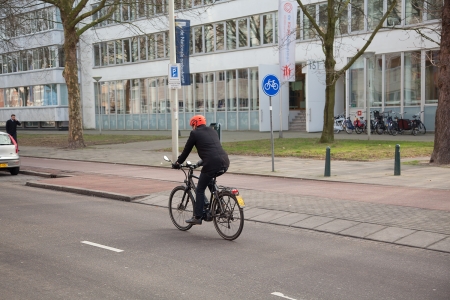No reliable data are available about crashes and numbers of kilometres travelled that can determine and compare the risk run by pedelec riders, speed pedelec riders and conventional cyclists. For pedelecs, some targeted (questionnaire) studies have been carried out. Their conclusions are not unequivocal: some studies do and others do not report an increased risk for pedelec riders. Regarding speed pedelec riders, as yet, only one (foreign) survey is available which concludes that speed pedelec riders and pedelec riders run an equal risk of being involved in single-bicycle crashes, but that injury risk is higher for speed pedelec riders.
Pedelecs
In the Netherlands, some surveys were carried out comparing bicycle crash casualties treated at an Emergency Department (ED) to a control group of cyclists not involved in a crash. A study which also checked for frequency of bicycle use, showed that pedelec riders ran a greater risk of ending up at an ED after a crash than users of conventional bicycles [16]. However, studies with a similar design which checked for travelled distance, found no average difference between these two groups [17] [18]. Yet, a breakdown by age and gender did show differences. The most recent survey [18] showed that an average of 2.8 ED visits were paid per 10 million cycled kilometres. The over-70s were most likely to have to visit an ED, with 5.2 visits by women and 3.2 visits by men. In addition, cyclists aged 12-17 ran a more than average risk of an ED visit after a pedelec crash, with 4.1 ED visits per 10 million pedelec kilometres by female cyclists and 3.2 visits by male cyclists.
A Norwegian survey [19] showed the risk of a pedelec crash to be greater than the risk of a crash with a conventional bicycle, but only for women. A German Naturalistic Cycling study [20] showed no differences in crash involvement between pedelecs and conventional bicycles, with the exception of intersection crashes. At intersections, crash involvement was twice as high for pedelecs as for conventional bicycles. Mostly, these intersection crashes occurred due to drivers not giving right of way. The results of a German experimental study that asked drivers to assess crossing situations involving cyclists shows that drivers keep a shorter distance from pedelecs than from conventional bicycles travelling at the same speed [21].
Most European studies looking at injury severity found that, but for two exceptions, the average severity of the outcome is equal for crashes with pedelecs and conventional bicycles [22] [23] [24] [25]. A Dutch study showed that ED casualties of a pedelec crash more often have multiple severe injuries and head/brain injuries, compared to casualties of a crash with a conventional bicycle [26]. A German study [27] also reports that casualties of a pedelec crash were more severely injured, had to be hospitalised more often, and had longer hospital stays than casualties of a crash with a conventional bicycle. What should be noted here, however, is that the average age of casualties of pedelec crashes was much higher that the average age of casualties of crashes with conventional bicycles (62 versus 48). Older people are known to sustain generally more severe injuries than younger people (see SWOV fact sheet Older road users). Since the German study did not correct for age, it is unclear to what extent either bicycle type or cyclist age determined the result.
Speed pedelecs
There is no study available which compares crash risk for speed pedelec riders to crash risk for conventional cyclists. A Swiss survey studied the risk of single-bicycle crashes for speed pedelec riders and pedelec riders [28]. The risk proved equal for both cyclist groups. Yet, the pedelec group did run a greater risk of sustaining injuries requiring medical care.
